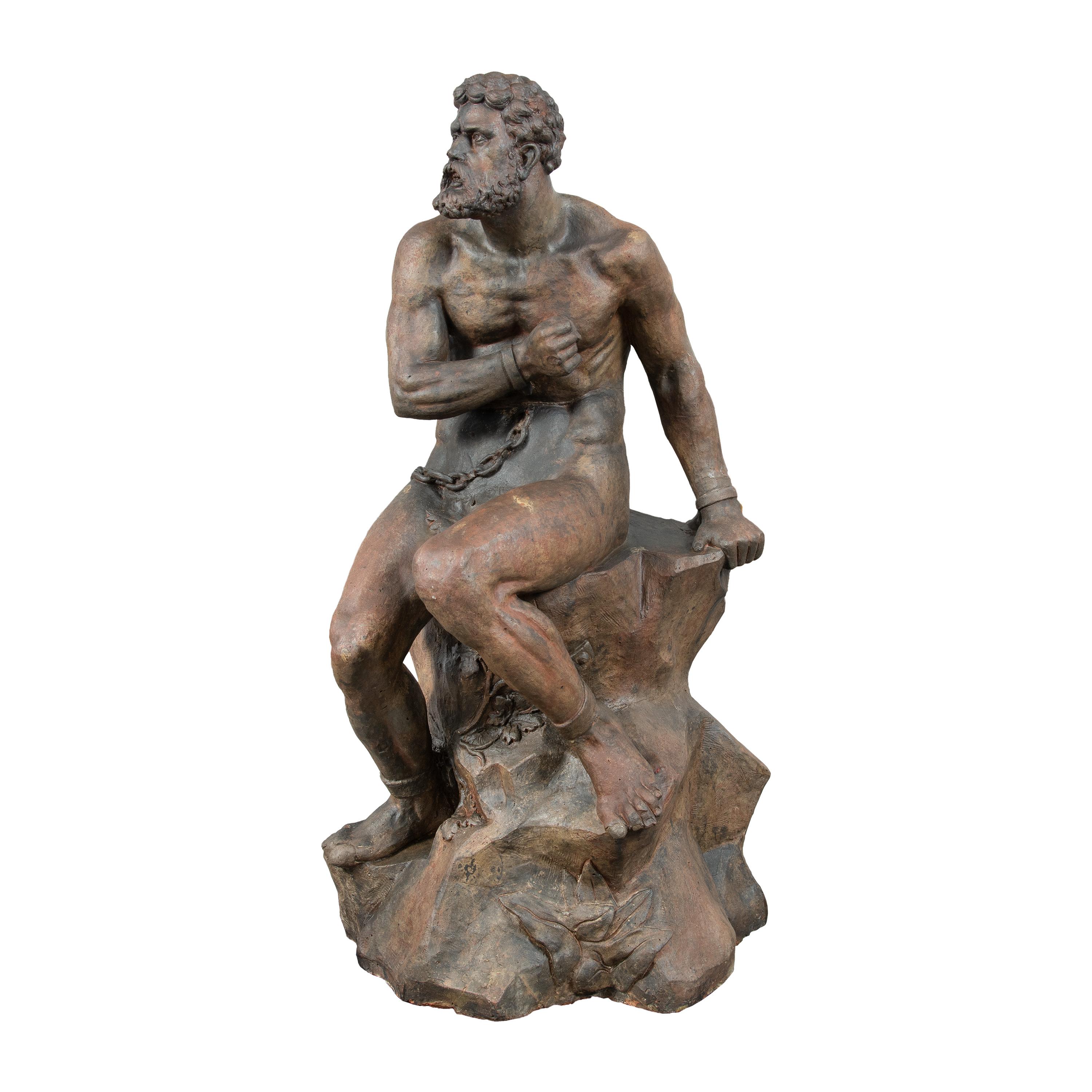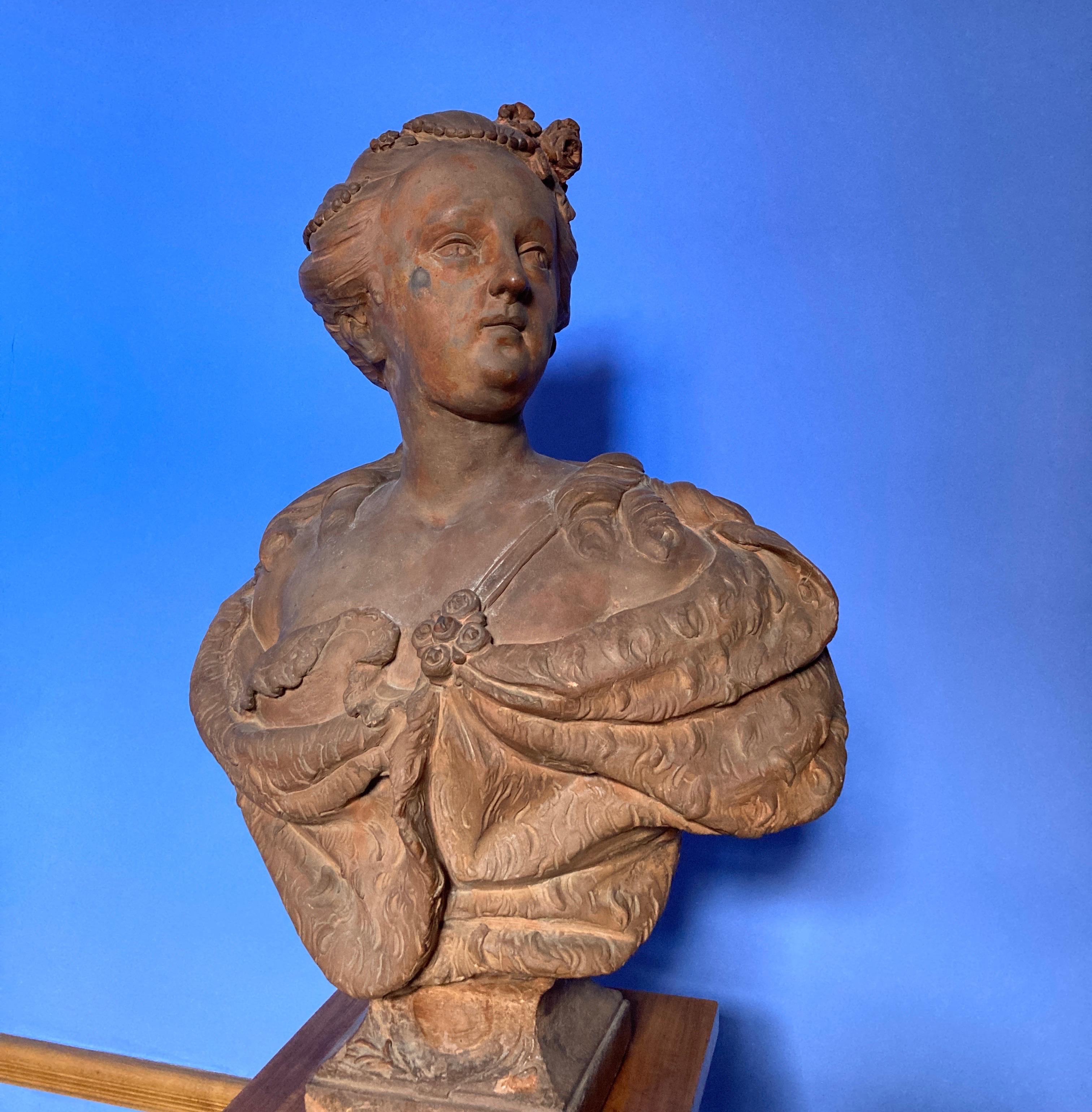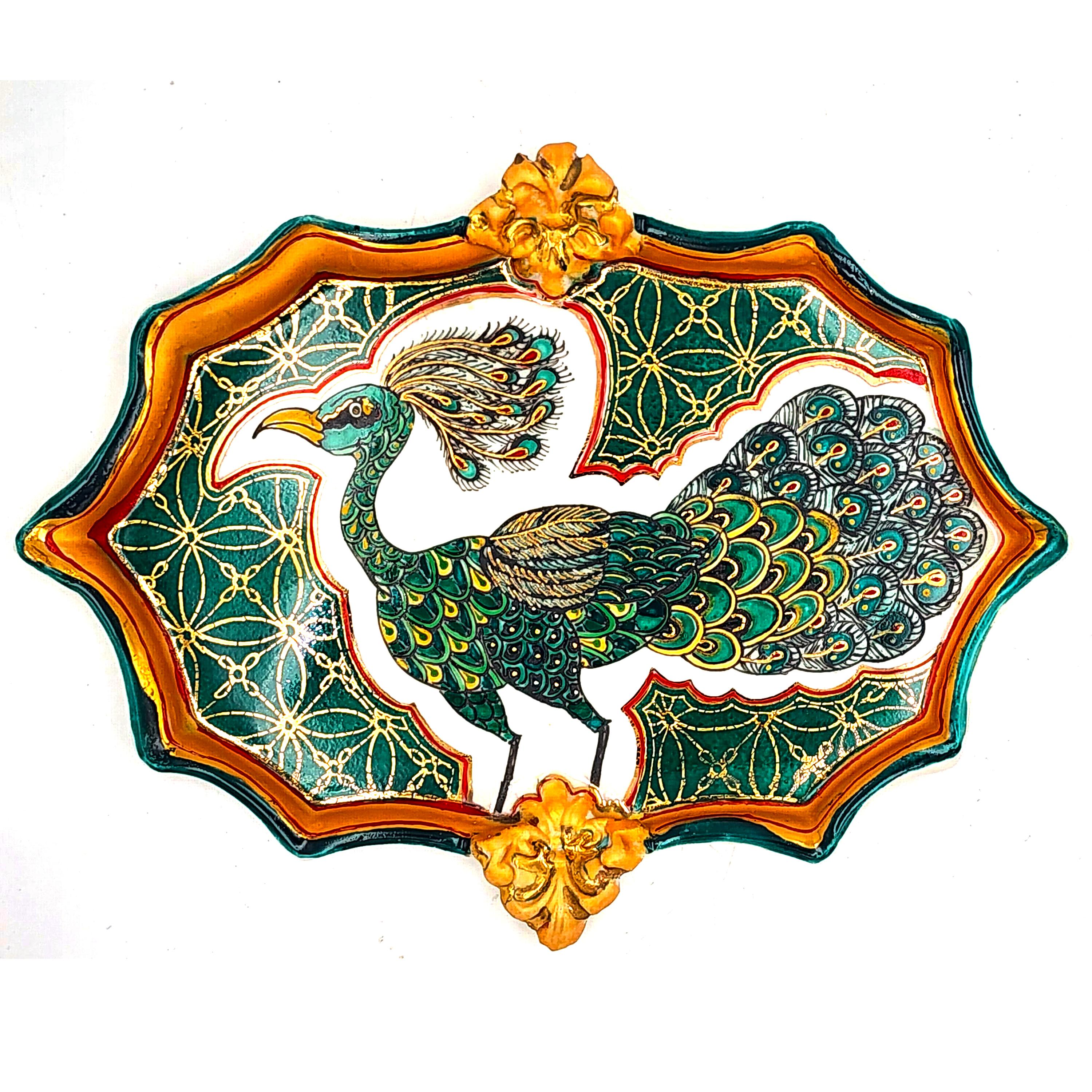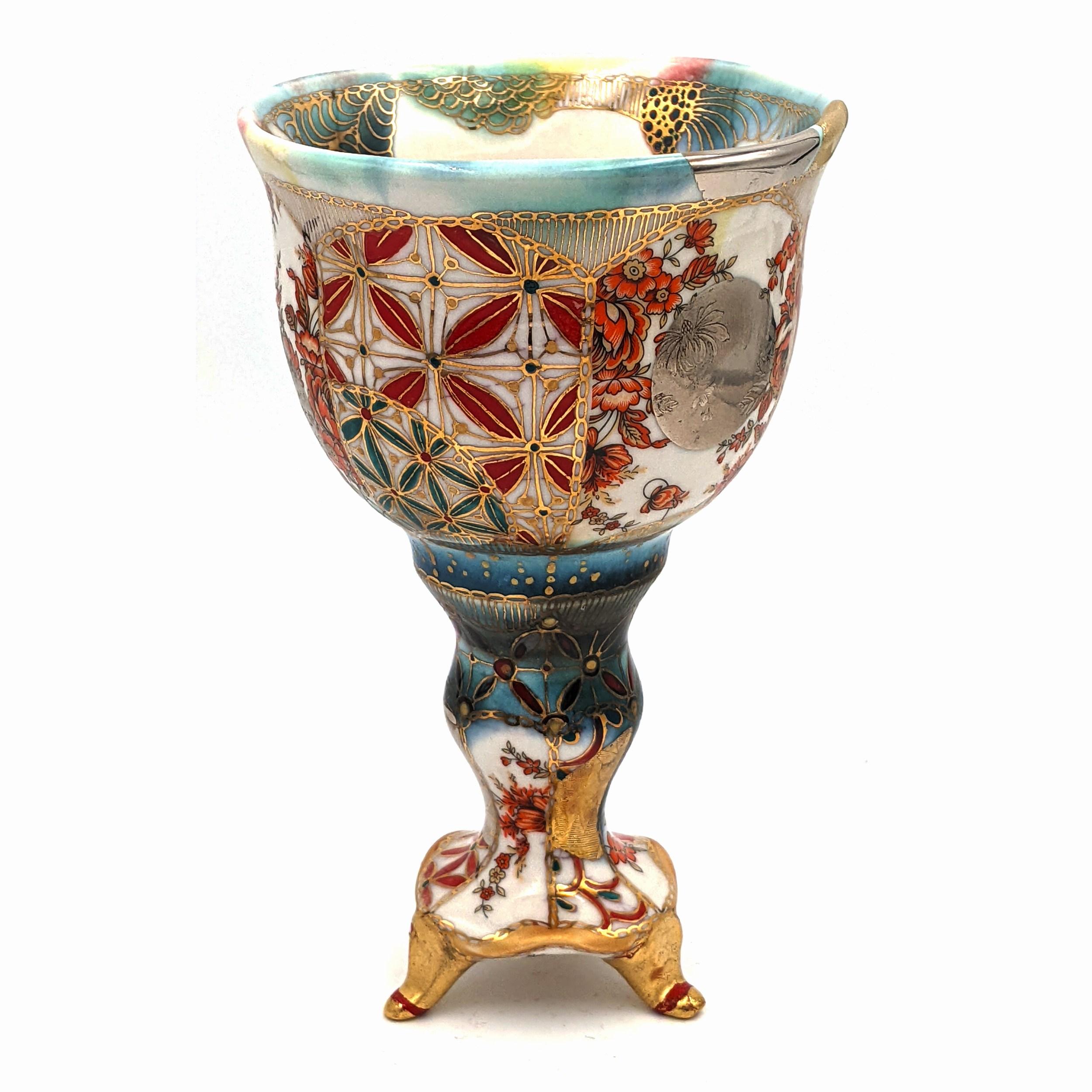Items Similar to Roman 18th century terracotta model for the sculpture of San Camillo de Lellis
Want more images or videos?
Request additional images or videos from the seller
1 of 6
Pietro PacilliRoman 18th century terracotta model for the sculpture of San Camillo de Lellis1751-3
1751-3
About the Item
This remarkably fluid terracotta bozetto was made in preparation for Pietro Pacilli’s most important public commission, a large-scale marble statue of San Camillo de Lellis for the nave of St Peter’s Basilica in Rome. Expressively modelled, this terracotta sculpture is a rare and significant work made by a major Roman sculptor at a transformative moment of European sculpture. Pacilli began his working life on the great Baroque decorative projects initiated in the seventeenth century, but he found success as a restorer of ancient sculpture working to finish antiquities for a tourist market, becoming an important figure in the emergence of an archaeologically minded Neoclassicism. Pacilli trained Vincenzo Pacetti and provided important decorative work for the Museo Pio-Clementino, at the same time he is recorded restoring some of the most celebrated antiquities excavated and exported during the period.
Pacilli was born into a family of Roman craftsmen, his father Carlo was a wood carver, and Pacilli is recorded working with him on the Corsini Chapel in San Giovanni Laternao as early as 1735. In 1738 his terracotta model of Joseph and Potiphar’s Wife won the first prize in the second class of the sculpture concorso at the Accademia di San Luca, this is particularly notable as Bartolomeo Cavaceppi came third. He worked as a carver and stuccoist completing works for the churches of San Marco and SS. Trinita dei Domeniciani Spagnoli. Pacilli operated as a sculptor and restorer of antiquities from his studio at the top of the Spanish Steps, close to Santa Trinita dei Monti, where he is listed as a potential vendor to the Museo Pio-Clementino in 1770.
In 1763 Pacilli completed a silver figure of San Venanzio for the treasury of San Venanzio. He is recorded as Pacetti’s first master and it was evidently through Pacilli that he began to acquire his facility as a restorer of ancient sculpture. Pacilli, at his studio ‘poco prima dell’Arco della Regina alla Trinita dei Monti,’ exercised, what the nineteenth-century scholar, Adolf Michaelis called ‘rejuvenating arts’ on several important pieces of classical sculpture, including in 1760 the group of a Satyr with a Flute for the natural brother of George III, General Wallmoden, Hanovarian minister at Vienna. In 1765, Dallaway and Michaelis record that Pacilli was responsible for the restorations, including the addition of a new head, to the Barberini Venus which he had acquired from Gavin Hamilton. The Venus was then sold to Thomas Jenkins, who in turn passed it on to William Weddell at Newby Hall. In 1767 Pacilli exported a series of ancient busts ‘al naturale’ including portraits of Antinous, Julius Ceaser and Marus Aurelius, also a statue of a Muse and a Venus. As early as 1756 Pacilli seems to have been operating as an antiquarian, helping to disperse the collection of the Villa Borrioni. Pacilli supplied sculpture to notable British collectors, including Charles Townley, who on his first trip to Italy purchased the Palazzo Giustiniani statue of Hecate from Pacilli. Pacilli was involved with the Museo Pio Clementino from its conception, supplying busts of Julius Ceaser and a Roman Woman as well as completing stucco putti surmounting the arms of Pope Bendedict XIV to signal the entrance to the new Museo Critiano.
In 1750 Il Diario Ordinario del Chracas announced that Pacilli had begun work on a sculpture of San Camillo de Lellis for St Peter’s. Camillo de Lellis founded his congregation, the Camillians, with their distinctive red felt crosses stitched on black habits in 1591. Having served as a soldier in the Venetian army, Camillo de Lellis became a novitiate of the Capuchin friars, he moved to Rome and established a religious community for the purpose of caring for the sick. In 1586 Pope Sixtus V formerly recognised the Camillians and assigned them to the Church of Santa Maria Maddalena in Rome. Camillo de Lellis died in 1614 and was entombed at Santa Maria Maddalena, he was canonised by Benedict XIV on June 26, 1746. It was an occasion that prompted the Camillians to make a number of significant artistic commissions, including two canvases by Pierre Subleyras showing episodes from San Camillo’s life which they presented to Benedict XIV. In 1750 Pacilli was commissioned to fill one of the large niches on the north wall of the nave with a sculpture of San Camillo.
The present terracotta bozetto presumably had two important functions, to enable Pacilli to work out his ideas for the finished sculpture and at the same time to show his design to the various commissioning bodies. In this case it would have been Cardinal Alessandro Albani and Monsignor Giovan Francesco Olivieri, the ‘economo’ or treasurer of the fabric of St Peter’s. Previously unrecorded, this terracotta relates to a smaller, less finished model which has recently been identified as being Pacilli’s first idea for his statue of San Camillo. Preserved in Palazzo Venezia, in Rome, the terracotta shows San Camillo with his left hand clutching his vestments to his breast; the pose and action more deliberate and contained than the finished sculpture. In producing the present terracotta Pacilli has expanded and energised the figure. San Camillo is shown with his left hand extended, his head turned to the right, apparently in an attempt to look east down the nave of St Peter’s. The model shows Pacilli experimenting with San Camillo’s costume; prominently on his breast is the red cross of his order, whilst a sense of animation is injected into the figure through the billowing cloak which is pulled across the saint’s projecting right leg. The power of the restrained, axial contrapposto of bent right leg and outstretched left arm, is diminished in the final sculpture where a baroque fussiness is introduced to the drapery. What Pacilli’s terracotta demonstrates, is that he conceived the figure of San Camillo very much in line with the immediate tradition of depicting single figures in St Peter’s; the rhetorical gesture of dynamic saint, arm outstretched, book in hand, head pointed upwards was perhaps borrowed from Camillo Rusconi’s 1733 sculpture of St. Ignatius Loyola, which was to the immediate left of the niche allotted to Pacilli. Rusconi’s example may also have prompted Pacilli’s addition in his model of a seated putto on the base of the sculpture clutching a crucifix, acting, as it does, as a visual balance to Rusconi’s sculpture which depicts Loyola trampling on a personification of heresy.
Elisa Debenedetti has proposed that a third model, painted white and installed in the church of Santa Maria Maddalena in Rome represents a development of the composition, but given how close it is in composition to the finished marble, it is more likely to be a model made after the project was completed. This makes the reappearance of the present sculpture particularly significant. We know from the correspondence of the sculptor Domenico Scaramucci, that Pacilli had initially been commissioned to complete a second sculpture for St Peter’s, that of San Gerolamo Emiliani, but he never completed the sculpture. Pacilli’s terracotta is exquisitely modelled, from the carefully accurate facial features, to the details of costume; whilst the back has been only roughly finished, consistent with a sketch not designed to be widely viewed. It survives in excellent condition with some modern restorations making good a few old and minor damages. Such bozetti became hugely desirable towards the end of the eighteenth century and were avidly collected by connoisseurs and artists, the present large, boldly modelled and beautifully finished figure is not only one of Pacilli’s masterpieces, but a particularly impressive terracotta made for the most important space in Rome.
- Creator:Pietro Pacilli (1720 - 1773, Italian)
- Creation Year:1751-3
- Dimensions:Height: 19.25 in (48.9 cm)Width: 11 in (27.94 cm)
- Medium:
- Movement & Style:
- Period:
- Condition:Terracotta in good condition, minor restoration to the fingers of the saint’s right hand and the cross of the putto.
- Gallery Location:London, GB
- Reference Number:1stDibs: LU150727729032
About the Seller
5.0
Recognized Seller
These prestigious sellers are industry leaders and represent the highest echelon for item quality and design.
1stDibs seller since 2021
- ShippingRetrieving quote...Ships From: London, United Kingdom
- Return PolicyA return for this item may be initiated within 14 days of delivery.
More From This SellerView All
- Eighteenth-century Grand Tour marble bust of Faustina the YoungerLocated in London, GBSigned and dated: ‘F. Harwood Fecit 1764’ Collections: Probably commissioned by Alexander Gordon, 4th Duke of Gordon (1743-1827); Probably by descent at Gordon Castle, Banffshire to c.1948; Possibly acquired by Bert Crowther of Syon Lodge, Middlesex; Jacques Hollander (1940-2004); Christie’s, 5 December 2013, lot 101; Private collection; Sotheby’s, 2 July 2019, lot 106 Literature: John Preston Neale, Views of the seats of noblemen and gentlemen, in England, Wales and Scotland, London, 1822, vol.I, unpaginated. This marble copy of an ancient bust in the Musei Capitolini usually identified as Faustina the Younger, the daughter of Antoninus Pius and future wife of Marcus Aurelius, was made in Florence by Francis Harwood in 1764. Harwood was one of the most prolific suppliers of decorative marbles for the Grand Tour market and this finely worked example demonstrates the quality of luxury goods available to travellers to Italy. So often anonymous, this unusually signed and dated example, raises questions about the status of marble copies in the period and of sculptors such as Harwood who are known principally for ornamental work. Harwood’s origins remain obscure. He is documented living in Palazzo Zuccari with Joshua Reynolds and the Irish sculptor Simon Vierpyl at Easter 1752, he had certainly settled permanently in Florence by the following year, when he is recorded working with Joseph Wilton. He was admitted to the Florentine Academy on 12 January 1755 (as pittore Inglese, although he was described as scultore in the matriculation account). After Wilson returned to England in 1755 Harwood appears to have worked in a studio near SS. Annunziata with Giovanni Battista Piamontini who had made life-size copies of The Wrestlers and The Listening Slave for Joseph Leeson in 1754. In 1758 both sculptors were contracted to make a statue and a trophy to complete the decoration of the Porta San Gallo, Harwood completing a statue of Equality, installed the following year. By 1760 Harwood was on the brink of his most productive period as a sculptor, producing copies of celebrated antiquities for the ever-increasing audience of Grand Tour travellers and for the domestic market in London. In 1761 Harwood met the young architect James Adam who was in Italy specifically to make contact with suppliers for Robert Adam’s burgeoning practice back in Britain. The Adams offered a remarkably cohesive design package to their clients, encompassing not just architecture, but fixtures, fittings and furniture as well. Harwood was able to supply the brothers with marbles for their new interiors. At Syon, for example, Harwood produced a full-size copy of Michelangelo’s Bacchus for the new dining room the Adams had designed for Hugh Smythson, 1st Duke of Northumberland. Harwood seems to have also specialised in producing sets of library busts. In 1758 Charles Compton, 7th Earl of Northampton, a distinguished traveller commissioned a set of busts which remain in situ at Castle Ashby in Northamptonshire. It is perhaps no coincidence that the Adam brothers were producing designs for new interiors at Castle Ashby at this date. The set included representations of: Cicero, Julius Caesar, Marcus Aurelius, Faustina the Younger, Sappho, Seneca and Homer. Each of these busts Harwood seems to have replicated for multiple patrons, another Adam patron, Thomas Dundas...Category
18th Century Old Masters Figurative Sculptures
MaterialsMarble
- 18th century oil sketches for a Baroque interior - a pairLocated in London, GBA FEAST OF THE GODS WITH VENUS AND BACCHUS Collections: With Appleby Brothers, London, June 1957; Hazlitt, Gooden & Fox, London, 1961; John and Eileen Harris, acquired from the above, to 2015. Literature: Jacob Simon and Ellis Hillman, English Baroque Sketches: The Painted Interior in the Age of Thornhill, 1974, cat. no.12 (as by Louis Laguerre); Elizabeth Einberg (ed.), Manners and Morals: Hogarth and British Painting, 1700-1760, exh. cat., London (Tate Gallery), 1987, cat. no.10 (as by Louis Laguerre); Tabitha Barber and Tim Bachelor, British Baroque: Power and Illusion, exh. cat., London (Tate Britain), 2020. Exhibited: Twickenham, Marble Hill House, English Baroque Sketches: The Painted Interior in the Age of Thornhill, 1974, no.12 (as by Louis Laguerre); London, Tate Gallery, Manners and Morals: Hogarth and British Painting, 1700-1760, 1987, no.10 (as by Louis Laguerre); London, Tate Britain, British Baroque: Power and Illusion, cat. no 92, 2020. CUPID AND PSYCHE BEFORE JUPITER Collections: With Appleby Brothers, London, June 1957; Hazlitt, Gooden & Fox, London, 1961; Anthony Hobson, acquired from the above, to 2015. These recently re-united paintings are the most ambitious surviving baroque ceiling sketches made in Britain in the early eighteenth century. From the Restoration until the rise of Palladianism in the 1720s decorative history painting formed the preeminent artistic discipline in Britain. It was a field dominated by Continental artists including the Italian Antonio Verrio and the Frenchmen Louis Laguerre and Louis Chéron...Category
Early 18th Century Baroque Figurative Paintings
MaterialsOil, Canvas
- 18th century allegorical painting of The Triumph of BeautyLocated in London, GBExhibited: London, Royal Academy, 1800, no. 93 What was happening in British history painting in around 1800? In recent discussions of the emergence of a British School of history painting following the foundation of the Royal Academy in 1768, this is a question which is rarely posed and one which is not easily answered. Examination of surviving Royal Academy exhibition catalogues reveals a profusion of artists’ names and titles, few of which remain immediately recognizable, whilst endeavours to explain the impact of exhibition culture on painting - such as the 2001 Courtauld show Art on the Line - have tended to focus on the first and second generation of Royal Academician, rather than young or aspiring artists in the early nineteenth century. This makes the discovery and identification of the work under discussion of exceptional importance in making sense of currents in English painting around 1800. Executed by Edward Dayes...Category
18th Century Old Masters Figurative Paintings
MaterialsCanvas, Oil
- 18th century portrait of the painter Nathaniel DanceLocated in London, GBCollections: Robert Gallon (1845-1925); Private Collection, UK. Oil on canvas laid down on panel Framed dimensions: 11.5 x 10 inches This highly engaging, previously unpublished portrait by Johan...Category
18th Century Old Masters Portrait Paintings
MaterialsOil, Wood Panel, Canvas
- 20th century British Drawing - Les Deux Landaises (Evening)By Gerald Leslie BrockhurstLocated in London, GBPencil on paper Signed 'G.L. Brockhurst’ (lower right) Drawn c.1920 Collections: The Fine Art Society, London, 1981; Mr & Mrs Alan Fortunoff, acquired from the above; Private col...Category
20th Century Figurative Drawings and Watercolors
MaterialsPencil
- Portraits of the Hon. Mary Shuttleworth and Anna Maria, 9th Baroness ForresterBy Daniel GardnerLocated in London, GBTHE HON. MARY SHUTTLEWORTH, NÉE COCKBURN (D. 1777) and her sister ANNA MARIA, 9TH BARONESS FORRESTER (D. 1808) Pastel and gouache on paper laid on canvas, on their original backb...Category
18th Century Old Masters Portrait Drawings and Watercolors
MaterialsGouache, Pastel
You May Also Like
- Baroque master sculptor - 18th century terracotta sculpture - Prometheus figureLocated in Varmo, ITTerracotta sculpture - Prometheus - Italy, 18th century. 48 x 50 cm x h 94 cm. Entirely in terracotta. - All shipments are free and professionally packed. - This item is sold wit...Category
Early 18th Century Baroque Figurative Sculptures
MaterialsTerracotta
- Bust of a Lady, prob Queen Elisabeth Petrowna, Terracotta Sculpture, Baroque ArtLocated in Greven, DEBust of a Lady, thought to be Elisabeth Petrowna, also known as Elisabeth of Russia Depicted before she was crowned Terracotta Bust Elizabeth Petrovna (Russian: Елизаве́та (29 Decem...Category
18th Century Baroque Figurative Sculptures
MaterialsTerracotta
- Vintage Peacock I (Wall Piece/Dish) (MADE TO ORDER) (~50% OFF LIMITED TIME ONLY)By Melanie ShermanLocated in Kansas City, MO(MADE TO ORDER) (Hand-painted, hand-made, porcelain) *Lead Time may vary between 1-3 weeks Melanie Sherman Vintage Peacock I (Wall Piece/Dish (handpainted) Porcelain, Glaze, Overglaze, Chinapaints, 24k German Gold Luster, Brass Wire (for hanging, can be removed) Year: 2022 Size: 4.5x6x0.5in Signed by hand COA provided Ref.: 924802-1330 ------------------------ My ceramics are handmade and painted with the finest overglazes from Europe. The gold luster used is 24k liquid Gold from Germany. Every piece is unique. My imagery is inspired by vintage Meissen dinnerware...Category
2010s Baroque Sculptures
MaterialsBrass
- Vintage Peacock III (Wall Piece/Dish (hand-painted, made to order by the artist)By Melanie ShermanLocated in Kansas City, MOMelanie Sherman Vintage Peacock III (Wall Piece/Dish (handpainted) Porcelain, Glaze, Overglaze, Chinapaints, 24k German Gold Luster, Brass Wire (for hanging, can be removed) Year: 20...Category
1790s Baroque Sculptures
MaterialsBrass
- Vintage Cobalt Blue and Gold Trim Limoges Porcelain Trinket Box FranceLocated in East Quogue, NYBeautiful vintage cobalt blue lidded porcelain trinket jewelry box with gold hand-painted floral decorative rim. The central illustration is of a couple dressed in Louis XVI period s...Category
Mid-20th Century Baroque Figurative Sculptures
MaterialsCeramic, Porcelain
- Just A Little Tipsy (MADE TO ORDER) (Sabbath, Kiddush, Unique, Gold Luster)By Melanie ShermanLocated in Kansas City, MO(MADE TO ORDER) (Sabbath, Kiddush, Unique, Gold Luster) *Lead Time may vary between 1-3 weeks Melanie Sherman "Just A Little Tipsy" Year: 2021 Porcelain, Glaze, ChinaPaint, 24k Germ...Category
Late 17th Century Baroque Sculptures
MaterialsLuster, Porcelain, Glaze
Recently Viewed
View AllMore Ways To Browse
Ancient Sculptures
Ancient Sculpture
Roman Sculpture
Church Sculpture
18th Century Italian Sculptures
Small Silver Sculptures
Large Classical Sculpture
Arm Sculpture
Rome Model
Roman Order
Roman Hand Sculpture
Facial Sculptures
Third Century Sculpture
Sculpture Rome Antique
White Classical Sculpture
Ancient Roman Sculpture
Sculpture Head Red
Italian Terracotta Sculpture





